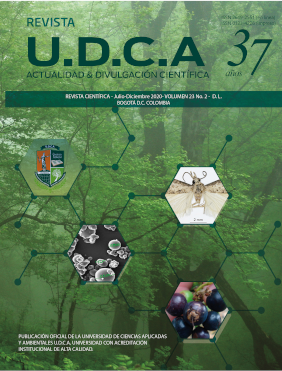Luz, giberelinas y profundidad de siembra inciden sobre la germinación de semillas de Amaranthus hybridus L.
Light, gibberellins and burial depth affect seed germination of Amaranthus hybridus L.
Contenido principal del artículo
Resumen
Amaranthus hybridus L., conocido como bledo, es una planta maleza en una gran variedad de cultivos en el mundo, que se caracteriza por producir alto número de semillas latentes. Para generar estrategias de manejo sostenibles en esta especie es necesario comprender mejor la fisiología de sus semillas. Por tanto, el objetivo fue evaluar el efecto de la luz, de las giberelinas y la profundidad de la siembra sobre la germinación de semillas de bledo. En un primer experimento, se evaluaron cuatro tratamientos de luz (rojo, azul, sin luz y luz natural «testigo»); en el segundo, se imbibieron semillas en diferentes concentraciones de ácido giberélico (0, 200, 400 y 800mg L-1 de GA3) y, en un último experimento, se evaluaron ocho profundidades de siembra (10, 20, 30, 40, 50, 60, 70 y 80mm), utilizando turba como sustrato. Se encontró mayor porcentaje de germinación en oscuridad, indicando que son semillas fotoblásticas negativas. Para el experimento de giberelinas, el mejor resultado se obtuvo con 400 y 800mg L-1 de ácido giberélico. En el tercer experimento, se observó alto porcentaje de emergencia de plántulas en las primeras profundidades (10mm a 30mm); a mayor profundidad hubo menor emergencia. La respuesta diferencial a la luz, a la aplicación de las giberelinas y el alto porcentaje de semillas viables que no germinaron permite concluir que semillas de bledo poseen latencia fisiológica.
Palabras clave:
Descargas
Datos de publicación
Perfil evaluadores/as N/D
Declaraciones de autoría
- Sociedad académica
- Universidad de Ciencias Aplicadas UDCA
- Editorial
- Universidad de Ciencias Aplicadas y Ambientales U.D.C.A
Detalles del artículo
Referencias (VER)
ASSAD, R.; RESHI, Z.A.; JAN, S.; RASHID, I. 2017. Biology of Amaranths. The Botanical Review. 83(4):382-436.
https://doi.org/10.1007/s12229-017-9194-1
AUFHAMMER, W.; CZUCZOROVA, D.; KAUL, H.-P.; KRUSE, M. 1998. Germination of grain amaranth (Amaranthus hypochondriacus × A. hybridus): effects of seed quality, temperature, light, and pesticides. European J. Agronomy, 8(1-2):127-135. https://doi.org/10.1016/s1161-0301(97)00049-x
BARROS‐GALVÃO, T.; DAVE, A.; GILDAY, A.D.; HARVEY, D.; VAISTIJ, F.E.; GRAHAM, I.A. 2019. ABA INSENSITIVE4 promotes rather than represses PHYA‐dependent seed germination in Arabidopsis thaliana. New Phytologist. 226:953-956. https://doi.org/10.1111/nph.16363
BASKIN, C.C.; BASKIN, J.M. 2014. Seeds: Ecology, Biogeography, and Evolution of Dormancy and Germination. Second ed. Academic Press (San Diego). 169p.
BASKIN, J.M.; BASKIN, C.C. 2004. A classification system for seed dormancy. Seed Science Research. (U.K). 14(1):1-16. https://doi.org/10.1079/SSR2003150
BEWLEY, D.J.; BRADFORD, K.J.; HILHORST, H.W.M.; NONOGAKI, H. 2013. Seeds: Physiology of Development, Germination and Dormancy. 3rd ed. Springer Science. 399p.
CARRANZA, C.; CASTELLANOS, G.; DEAZA, D.; MIRANDA, D. 2016. Efecto de la aplicación de reguladores de crecimiento sobre la germinación de semillas de badea (Passiflora quadrangularis L.) en condiciones de invernadero. Revista Colombiana de Ciencias Hortícolas, 10(2): 284-291. https://doi.org/10.17584/rcch.2016v10i2.5791
CASTILLO, M.; BUSTAMANTE, O.R.; PEÑA-GÓMEZ, F.T.; GUTIÉRREZ, V.L.; REYES, C.A.; ARREDONDO-NÚÑEZ, A.; MAREY, M. 2013. Negative photoblastism in the invasive species Eschscholzia californica Cham. (Papaveraceae): Patterns of altitudinal variation in native and invasive range. Gayana Botanica. 70(2):330-336. https://doi.org/10.4067/S0717-66432013000200010
FENNER, M.W. 2012. Seed Ecology. Springer Science & Business Media. 151p.
FLORES-CÓRDOVA, M.A.; SÁNCHEZ-CHÁVEZ, E.; BALANDRÁN-VALLADARES, M.I.; MÁRQUEZ-QUIROZ, C. 2016. Efectividad de tratamientos pre-germinativos en la ruptura de la dormancia en las semillas forrajeras y de malezas. Ecosistemas y recursos agropecuarios. 3(9):427-432.
IDRIS, L.M.; NULIT, R.; ZAMAN, F.Q.; ARIFIN, F.K.M. 2020. Hydrotime analysis of Amaranthus spp. seed germination under salinity condition. Journal of Applied Research on Medicinal and Aromatic Plants. In Press. https://doi.org/10.1016/j.jarmap.2020.100249
JIMOH, M.O.; AFOLAYAN, A.J.; LEWU, F.B. 2019. Germination response of Amaranthus caudatus L. to soil types and environmental conditions. Thaiszia J. Botany. 29(1):85-100. https://doi.org/10.33542/TJB2019-1-07
KENDRICK, R.E.; FRANKLAND, B. 1969. Phytocontrol of germination in Amaranthus caudatus. Planta. 85:326329.
KULKARNI, M.G.; SPARG, S.G.; VAN STADEN. J. 2006. Dark conditioning, cold stratification and a smoke-derived compound enhance the germination of Eucomis autumnalis subsp. autumnalis seeds. South African J. Botany. 72:157-162. https://doi.org/10.1016/j.sajb.2005.06.006
LI, T.; SUN, J.; YANG, H.; LIU, J.; XIA, J.; SHAO, P. 2020. Effects of shell sand burial on seedling emergence, growth and stoichiometry of Periploca sepium Bunge. BMC Plant Biol. 20:112. https://doi.org/10.1186/s12870-020-2319-4
MARTÍNEZ M., F.E.; MIRANDA L., D.; MAGNITSKIY, S. 2016. Sugar apple (Annona squamosa L.) seed germination affected by the application of gibberellins. Agronomía Colombiana. 34(1):17-24. https://dx.doi.org/10.15446/agron.colomb.v34n1.53074
MÉRAI, Z.; GRAEBER, K.; WILHELMSSON, P.; ULLRICH, K.K.; ARSHAD, W.; GROSCHE, C.; TARKOWSKÁ, D.; TUREČKOVÁ, V.; STRNAD, M.; RENSING, S.A.; LEUBNER-METZGER, G.; SCHEID, O. 2019. Aethionema arabicum: a novel model plant to study the light control of seed germination. J. Experimental Botany, 70(12):3313-3328. https://doi.org/10.1093/jxb/erz146
PARAÍSO, H.A.; BRANDÃO JR, D.D.S.; AVELAR, R.I.; C., COSTA, A. DA.; GOMES, L.S.; NASCIMENTO, W.M. 2019. Adjustments in the tetrazolium test methodology for assessing the physiological quality of chickpea seeds. J. Seed Science. 41(1):7-12. https://doi.org/10.1590/2317-1545v41n1187777
PENFIELD, S. 2017.Seed dormancy and germination. Current Biology. 27(17):874-878. https://doi.org/10.1016/j.cub.2017.05.050
PORRAS, Y.; PEDREROS, M.; REYES-ARDILA, W.; BALAGUERA-LOPEZ, H. 2020. Light Effect on germination of Champa (Campomanesia lineatifolia R. & P.) seeds. Ciencia y Agricultura, 17(2):23-31. https://doi.org/10.19053/01228420.v17.n2.2020.10979
RASTOGI, A.; SHUKLA, S. 2013. Amaranth: a new millennium crop of nutraceutical values. Critical Review in Food Science and Nutrition. 53(2):109-125. https://doi.org/10.1080/10408398.2010.517876
RUÍZ HERNÁNDEZ, V.C.; LEGARÍA SOLANO, J.P.; SAHAGÚN CASTELLANOS, J.; DE LAO OLAN, M. 2018. Variabilidad genética en algunas especies cultivadas y silvestres de amaranto. Rev. Mex. Ciencias Agrícolas. 9(2):405-416. https://doi.org/10.29312/remexca.v9i2.1081
SAVAEDI, Z.; PARMOON, G.; MOOSAVI, S.A.; BAKHSHANDE, A. 2019. The role of light and Gibberellic Acid on cardinal temperatures and thermal time required for germination of Charnushka (Nigella sativa) seed. Industrial Crops & Products. 132:140-149. https://doi.org/10.1016/j.indcrop.2019.02.025
SHU, K.; LIU, X.D.; XIE, Q.; HE, Z.H. 2016. Two faces of one seed: hormonal regulation of dormancy and germination. Molecular Plant. 9(1):34-45. https://doi.org/10.1016/j.molp.2015.08.010
SIVAKUMAR, D.; CHEN, L.; SULTANBAWA, Y. 2018. A comprehensive review on beneficial dietary phytochemicals in common traditional Southern African leafy vegetables. Food science & nutrition. 6(4):714-727. https://doi.org/10.1002/fsn3.643
STAWSKA, M.; ORACZ, K. 2019. PhyB and HY5 are involved in the blue light-mediated alleviation of dormancy of Arabidopsis seeds possibly via the modulation of expression of genes related to light, GA, and ABA. Internal J. Molecular Sciences. 20(23):5882. https://doi.org/10.3390/ijms20235882
TAKAKI, M. 2001. New proposal of classification of seeds based on forms of phytochrome instead of photoblastism. Rev. Brasileira de Fisiología Vegetal. 13(1):103-107. https://doi.org/10.1590/S0103-31312001000100011
TAYLORSON, R.B. 1991. Inhibition of germination in Amaranthus albus seed by prolonged irradiation: a physiological basis. Seed Science Research. 1(1):51-56. https://doi.org/10.1017/S0960258500000635
VALDEZ-ELEUTERIO, G.; USCANGA-MORTERA, E.; KOHASHI-SHIBATA, J.; GARCÍA-NAVA, R.; MARTÍNEZ-MORENO, D.; TORRES-GARCÍA, J.; GARCÍA-ESTEVA, A. 2015. Tamaño de semilla, granulometría del sustrato y profundidad de siembra en el vigor de semilla y plántula de dos malezas. Agrociencia. 49(8):899-915.
XAVIER, J.B.; ANDRADE, D.B.D.; SOUZA, D.C.D.; GUIMARÃES, G.C.; RESENDE, L.V.; GUIMARÃES, R.M. 2019. Morphological, chemical and physiological characterization of Amaranthus spp. Seeds.J. Seed Science. 41(4):478-487. https://doi.org/10.1590/2317-1545v41n4226286
YANG, L.; PENG, D.; ZHI-MIN, L.; HUANG, L.; YANG, J.; SUN, H. 2020. Cold stratification, temperature, light, GA3, and KNO3 effects on seed germination of Primula beesiana from Yunnan, China. Plant Diversity. In press. https://doi.org/10.1016/j.pld.2020.01.003
ZHANG, Z.S.; KANG, Y.J.; CHE, L. 2019. Composition and thermal characteristics of seed oil obtained from Chinese amaranth. LWT–Food Science and Technology. 111:39-45. https://doi.org/10.1016/j.lwt.2019.05.007
ZIMDAHL, R.L. 2018. Fundamentals of weed science. 5th ed. Academic Press. 785p.







